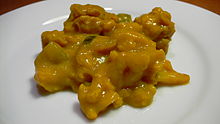Piccalilli

Mustard piccalilli
|
|
| Place of origin | English |
|---|---|
| Main ingredients | pickled vegetables and spices |
| |
|
Piccalilli is an English interpretation of Indian pickles, a relish of chopped pickled vegetables and spices; regional recipes vary considerably.
The Oxford English Dictionary traces the word to the middle of the 18th century when, in 1758, Hannah Glasse described how "to make Paco-Lilla, or India Pickle". An apparently earlier reference is in Lady Anne Blencowe's "Receipt Book", written c. 1694, which has "To Pickle Lila, an Indian Pickle" credited to Lord Kilmory.
The more familiar form of the word appears in 1769, in Elizabeth Raffald's The Experienced English Housekeeper, as "To make Indian pickle, or Piccalillo". Richard Briggs, in his 1788 The English Art of Cookery, similarly calls it "Picca Lillo". The spelling "piccalilli" can be seen in an advertisement in a 1799 edition of The Times.
British piccalilli contains various vegetables – invariably cauliflower, onion, and gherkin – and seasonings of mustard and turmeric. A more finely chopped variety "sandwich piccalilli" is also available from major British supermarkets. It is used as an accompaniment to foods such as sausages, bacon, eggs, toast, cheese, and tomatoes. It is similar to a sweet pickle such as Branston Pickle, except it is tangier and slightly less sweet, coloured bright yellow (using turmeric) rather than brown, and the chunks are larger. It is usually used to accompany a dish on a plate rather than as a bread spread. It is popular as a relish with cold meats such as ham and brawn, and with a ploughman's lunch. It is produced both commercially and domestically, the latter product being a traditional mainstay of Women's Institute and farmhouse product stalls.
...
Wikipedia
